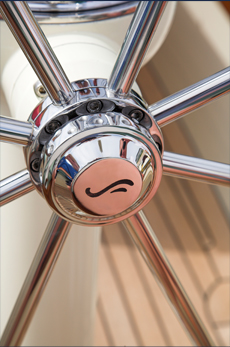About Us

Wetted Surface
Another common question that we often hear regarding performance is, “How can a heavier displacement boat move in light air? After all, a boat must be light to move well in less than 8-10 knots of breeze.” This seems logical, but is not always true, as proven by the racing success of many Fontaine designed boats in light air conditions. But why?
There are three forms of resistance to a hull moving through the water: wave-making, form, and frictional. In light winds, when a boat is moving well below maximum speed, the overriding component of resistance is skin friction of the water along the hull surface because there is less turbulent flow. Therefore we strive to shape our heavier displacement hull in such a way that minimizes the wetted surface area below the waterline. A rowing shell has a hull section that is completely circular because that shape provides the least wetted surface for a given displacement. While the Friendship 40’s hull depth and waterline beam are mostly for stability reasons, as explained previously, her rounded “V” sections follow the same goals of maximizing displacement (i.e. cruising amenities and interior volume) with a minimum hull surface area.
Comparing a cross-section of each hull once again, we have noted how the Friendship 40’s shallow-draft, heavy displacement hull has a smaller “chain girth” measurement (Refer to diagram). That is, the distance measured on an imaginary string running from the waterline to the bottom of the keel is shorter, meaning that when averaged out over the length of the hull, the wetted surface is comparable or less than a light displacement hull. In this manner, a heavier displacement hull can maintain fast, “straight-line” speed in light air if the displacement is distributed properly.
Admittedly, the Friendship 40 will not perform as well when short-tacking up a narrow channel because of the longer time needed to accelerate. In heavy air sailing downwind, a lighter boat will certainly surf more easily. But for the average cruising sailor looking to make a fast passage in safety and comfort, these qualities are not a high priority because the typical wind conditions under which we sail is less than twenty knots.
